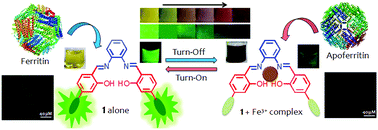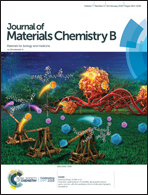Simultaneous sensing of ferritin and apoferritin proteins using an iron-responsive dye and evaluation of physiological parameters associated with serum iron estimation†
Abstract
An iron-responsive optical probe has been developed for simultaneous sensing of both ferritin and apoferritin proteins at pH 7.4 in water. The compound showed an exclusive response (turn-off signal) towards ferritin among a wide range of proteins even at nanomolar concentration. In contrast, apoferritin dissociates the preformed iron complex and revives the green colored fluorescence of the native probe (turn-on signal). Subsequently, various parameters associated with the serum iron level are evaluated, which are beneficial for clinical diagnosis of many iron-related diseases, including anemia. Estimation of iron was achieved in a wide range of edible plant materials as well as pharmaceutical formulations. Subsequently, different kinds of natural water samples were screened for quantification of soluble iron contents. In addition to traditional spectroscopic tools, dye-coated paper strips were developed as an alternative strategy for onsite ‘instrument-free’ detection of iron. Highly specific bioimaging of Fe3+ was achieved in cervical cancer cells (HeLa).



 Please wait while we load your content...
Please wait while we load your content...